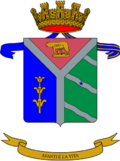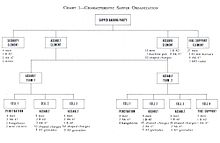- Sapper
-
For other uses, see Sapper (disambiguation).The sappers ("sapeurs") of the French Foreign Legion traditionally sport large beards, wear leather aprons and gloves and carry axes.

A sapper, pioneer or combat engineer is a combatant soldier who performs a wide variety of combat engineering duties, typically including, but not limited to, bridge-building, laying or clearing minefields, demolitions, field defences, general construction and building, as well as road and airfield construction and repair. They are also trained to serve as infantry personnel when needed in both defensive and offensive operations and are fully involved in modern counter-insurgency operations. A sapper's tasks have, throughout history, including modern day counter-insurgency operations, been devoted to the mission-critical tasks involving facilitating movement and logistics of allied forces and impeding those of enemies.
The term "sapper" is used in the British Army, Polish Army and Commonwealth nations' military services. In the United States Army and United States Air Force, the term sapper leader has been instituted to indicate combat engineers who have met additional professional qualifications that demonstrate a certain level of proficiency and accomplishment as a small unit leader of combat engineers.[1] An ordinary engineer who has completed his training is called a pioneer. The German Army uses the term Pionier, while sapeur is used in the French Army, and guastatore (more precisely defined as an assault engineer) in the Italian Army.
Contents
Historical origin
Sapper
See also: Sapping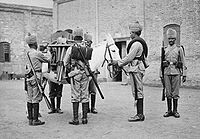 Soldiers of No 2 Field Company, Bombay Sappers and Miners on duty in China in 1900. The mule carries the tools required for field engineering tasks.
Soldiers of No 2 Field Company, Bombay Sappers and Miners on duty in China in 1900. The mule carries the tools required for field engineering tasks.
A sapper, in the sense first used by the Assyrian Army in the early 7th Century BC[citation needed], was one who excavated trenches under defensive fire to advance a besieging army's position in relation to the works of an attacked fortification, which was referred to as sapping the enemy fortifications.
Saps were excavated by brigades of trained sappers or instructed troops. When an army was defending a fortress with cannon, they had an obvious height and therefore range advantage over the attacker's own guns. The attacking army's artillery had to be brought forward, under fire, so as to facilitate effective counter-battery fire.
This was achieved by digging what the French termed a 'Sappe'. Using techniques developed and perfected by Vauban, the sapeurs (sappers) began the trench at such an angle so as to avoid enemy fire 'enfilading' (passing directly along) the sappe. As they pressed forward, a position was prepared from which cannon could suppress the defenders on the bastions. The sappers would then change the course of their trench, zig-zagging their way toward the fortress wall.
Each leg brought the attacker's artillery closer and closer until (hopefully) the besieged cannon would be sufficiently suppressed for the attackers to breach the walls with their artillery. Broadly speaking, sappers were originally experts at demolishing or otherwise overcoming or bypassing fortification systems.
Miner
See also: Mining (military)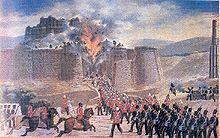 The fort of Ghazni which fell as a result of mining by a mixed contingent of the Bombay and Bengal Sappers during the First Afghan War on 23rd July 1839.
The fort of Ghazni which fell as a result of mining by a mixed contingent of the Bombay and Bengal Sappers during the First Afghan War on 23rd July 1839.
An additional term applied to sappers of the British Indian Army was 'miner'. The native engineer corps were referred to as 'sappers and miners', as for example, the Royal Bombay Sappers and Miners. The term arose from a task done by sappers to further the battle after saps were dug. The saps permitted cannon to be brought into firing range of the besieged fort and its cannon, but often the cannon themselves were unable to breach the fort walls. The engineers would dig a tunnel from the forward-most sap up to and under the fort wall, then place a charge of gunpowder and ignite it, causing a tremendous explosion which would destroy the wall and permit attacking infantry to close with the enemy. This was dangerous work, often lethal to the sappers, and was vehemently resisted by the besieged enemy. Since the two tasks went hand in hand and were done by the same troops, native Indian engineer corps came to be called 'sappers and miners'.
Specific usage
Commonwealth of Nations
Sapper (abbreviated Spr) is the Royal Engineers' equivalent of Private. This is also the case within the Indian Army Corps of Engineers, Canadian Military Engineers, Royal Australian Engineers,[2] South African Army Engineer Formation and Royal New Zealand Engineers. The term Sapper was introduced in 1856 when the Corps of Royal Sappers and Miners was amalgamated with the officer Corps of Royal Engineers to form the Corps of Royal Engineers.
Indian Army
Main article: Indian Army Corps of EngineersThe term 'Sappers', in addition to the connotation of rank of engineer private, is used collectively to informally refer to the Engineer Corps as a whole and also forms part of the informal names of the three combat engineer groups, viz. Madras Sappers, Bengal Sappers and the Bombay Sappers. Each of these groups consist of about twenty battalion-sized engineer regiments and additional company-sized minor engineer units. The three Sapper groups are descended from the Sapper and Miner groups of the East India Company and later the British Indian Army of the British Raj.
Israel Defence Forces
Main article: Combat Engineering CorpsIn the Israel Defence Forces a sapper (in Hebrew: פלס, palas) is the military profession of a combat soldier who went through basic combat engineering training. Most of the sappers are soldiers of the Combat Engineering Corps, but there are also infantry sappers, who are part of the infantry brigades and are organized in Engineering companies called פלחה"ן (Palchahan). These companies are integral part of the infantry brigades. Combat engineering corps sappers are arranged in battalions.
Each sapper goes through high level infantry training, which qualifies him as Rifleman 07 (רובאי 07). Combat engineering sappers are qualified as Sapper 06 (פלס 06). They are skilled in infantry combat, basic sabotage, landmine planting and demining, use of explosives, breaching and opening routes, trench warfare, and operating the IDF Puma combat engineering vehicle (CEV). Combat engineering commanders are qualified as Sapper 08 while combat engineering officers are qualified as Sapper 11. Both go through additional advance training to gain the skills needed for high level sapper profession.
France
 Sapeurs-pompiers de Paris (Paris Fire Brigade)
Sapeurs-pompiers de Paris (Paris Fire Brigade)
In France, the civil firefighters and the military firefighters of the Paris Fire Brigade and other town or country brigades are called "sappers-firemen" (sapeurs-pompiers, SP): the first fire company created by Napoléon I was a military sappers company. Apart from this, the sappers are the combat engineers.
The sappers were very common in the French army and in other European armies during the Napoleonic era but progressively disappeared in the 19th century, except in the French Foreign Legion, which retains a sapper unit.
In the French Army, since the 18th century, every grenadier battalion had a small unit of sappers. They had the mission to advance, under the enemy's fire, in order to destroy with their axes the obstacles drawn by the enemy and to clear the way for the rest of the infantry. The danger of such missions and their short life expectancies, allowed them certain privileges, such as the authorization to wear beards. In addition to their beards and axes, they traditionally wear leather aprons and gloves.
The current pioneer unit of the Legion reintroduced the symbols of the Napoleonic sappers: the beard, the axe, the leather apron, the crossed-axes insignia and the leather gloves. If the parades of the Legion are opened by this unit, it is to commemorate the traditional role of the sappers "opening the way" for the troops.
Greece
In Greece, there is the "Mechanic" or "Corps of Engineers" (Michaniko-Μηχανικό).
United States Army
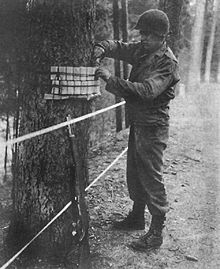 US Combat Engineer setting a charge in World War II
US Combat Engineer setting a charge in World War II
In the U.S. Army, sappers are combat engineers who support the front-line infantry, and they have fought in every war in American history. For example, after the Battle of Yorktown, General Washington cited Louis Lebègue Duportail, the U.S. Army's first Chief of Engineers, for conduct which afforded "brilliant proofs of his military genius."
Designation as a sapper nowadays is earned as an additional proficiency. The U.S. Army authorizes three skill tabs[3] for permanent wear above the unit patch on the left shoulder (Army Regulation 670-1 Chapter 29-13, Sub-Paragraph f). Along with the Sapper Tab, the Special Forces Tab and the Ranger Tab identify soldiers who have passed a demanding course of military instruction and demonstrated their competence in particular specialities and skills.
To wear the Sapper Tab, a soldier must complete the Sapper Leader Course (SLC) which is operated by the U.S. Army Engineer School at Fort Leonard Wood, Missouri. The Sapper Leader Course is a 28-day course designed to train joint-service leaders in small unit tactics, leadership skills, and tactics required to perform as part of a combined arms team. The course is open to enlisted soldiers in the grades of E-4 (P) (in the Army, specialist on the list for promotion to sergeant) E-5, and above, cadets, and officers O-3 (Army, captain) and below. Students can come from any combat or combat support branch of the service, but priority is given to engineering, cavalry, and infantry soldiers.[4]
PAVN and Viet Cong
PAVN (People's Army of Vietnam) and Viet Cong sappers, as they were called by US forces, are better described as commando units. The Vietnamese term "đặc công" can be literally translated as "special task". Thousands of specially trained elite fighters served in the PAVN and Viet Cong commando/sapper units which were organized as independent formations. While not always successful due to lack of appropriate personal weapon types for combat and assault like other special forces, at times they inflicted heavy damage against their enemies. They have been armed with various types of bombs, mines, explosive charges, grenades and even steel-pellet mines which were much more devastating than the U.S M18 Claymore[citation needed] and are still the main weapons of the Dac cong. These elite units served as raiders against American/ARVN troops, and infiltrated spearheads during the final Ho Chi Minh Campaign in 1975 – where they seized key road and bridge assets, destroyed installations, attacked command and control nodes located deep inside enemy territory, and otherwise helped the PAVN's rapid mobile forces advance. A typical PAVN/VC Dac cong organization is shown in the diagram. The raiding force was usually grouped into assault teams, each broken down into several 3–5 man assault cells. Overall, there were generally 4 operational echelons.[5]
Honours
Sapper Island, St. Joseph Channel, Algoma District, Ontario was named in honour of Sappers, especially those who graduated from the Royal Military College of Canada.[6] 46°18′56″N 83°57′29″W / 46.31556°N 83.95806°W
See also
- Assault pioneer
- List of military engineer nomenclatures
- Trooper (rank)
- Viet Cong and PAVN Sapper attacks
Notes
- ^ U.S. Sapper Leader Course, Fort Leonard Wood, Missouri.
- ^ Jobson 2009, p. 96.
- ^ Wear and Appearance of Army Uniforms and Insignia US Army
- ^ Sapper Course, US Army, archived from the original on 9 September 2006, http://web.archive.org/web/20060909052300/http://www.wood.army.mil/sapper/course.htm
- ^ Ott 1975, pp.1–42.
- ^ "Full text of Ontario history". 1913. http://www.archive.org/stream/ontariohistory1011ontauoft/ontariohistory1011ontauoft_djvu.txt. Retrieved 28 October 2010.
References
- Jobson, Christopher (2009), Looking Forward, Looking Back: Customs and Traditions of the Australian Army, Wavell Heights, Queensland: Big Sky Publishing, ISBN 9780980325164
- Ott, David Ewing, (1975), Vietnam Studies, Field Artillery, 1954–1973, Washington, D.C.: United States Army Center of Military History, http://www.history.army.mil/books/Vietnam/FA54-73/fm.htm
External links
- Royal Engineers Museum – History of the Royal Engineers (The Sappers)
- Royal Engineers Museum – Origins of the term "Sapper"
- [http://www.sappers.co.uk/ - Site for tracking down former members of the Royal Engineers.
- Dec 1918 Popular Science World War 1 article about a French engineer using a ground stethoscope to listen for German sappers – Listening to Enemy Sappers, Popular Science monthly, January 1919, page 27, Scanned by Google Books
- Sapper-Museum, virtual museum of Russian engineering troops
- A.-M. Zielenski , Colonel (sapper), Military Engineer
- Comandosupremo.com, guastatore.
Categories:- USA and Europe-centric
- Land warfare
- Combat occupations
- Military engineering
Wikimedia Foundation. 2010.


